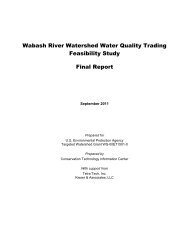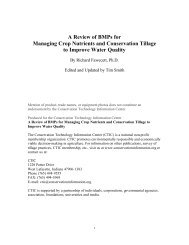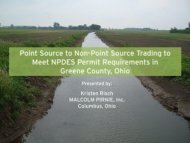Facilitating Conservation Farming Practices and Enhancing ...
Facilitating Conservation Farming Practices and Enhancing ...
Facilitating Conservation Farming Practices and Enhancing ...
You also want an ePaper? Increase the reach of your titles
YUMPU automatically turns print PDFs into web optimized ePapers that Google loves.
Inventory, a report to Congress, the U.S. Environmental Protection<br />
Agency (EPA) stated that sediment was the number-one pollutant in<br />
American rivers <strong>and</strong> streams, followed by bacteria, then organic enrichment/oxygen<br />
depletion (U.S. EPA, 2004).<br />
Andraski et al. (1985) compared losses of three forms of phosphorus<br />
in runoff from four tillage systems – no-till, chisel plowing, strip-till <strong>and</strong><br />
moldboard plowing. No-till reduced losses of total phosphorus by 81<br />
percent; conservation tillage with a chisel reduced total phosphorus<br />
run-off by 70 percent <strong>and</strong> strip-till reduced it by 59 percent compared<br />
to moldboard plowing. Baker <strong>and</strong> Laflen’s (1983) study compared total<br />
phosphorus losses between no-till <strong>and</strong> conventional tillage <strong>and</strong> found<br />
that no-tilling soybeans following corn reduced phosphorus loss in the<br />
soybeans by 80 to 91 percent compared to conventional tillage. They<br />
also found that no-till corn following soybeans resulted in an 86-percent<br />
reduction in soil loss, which in turn led to a 66-to-77-percent reduction<br />
in the loss of phosphorus.<br />
Results of this type illustrate conservation tillage <strong>and</strong> no-till are<br />
extremely useful practices for reducing nutrient loads in surface waters<br />
– a fact being employed in water quality trading programs discussed<br />
later in this document.<br />
Crop residue left on the soil surface by no-till or conservation tillage<br />
practices can significantly reduce topsoil erosion by wind. Crop residues<br />
reduce wind velocity at the soil surface, <strong>and</strong> trap soil particles to<br />
stop their movement (Lyon <strong>and</strong> Smith, 2004). Covering 30 percent of the<br />
soil surface reduces soil loss to wind erosion by 70 percent compared<br />
to bare soil, <strong>and</strong> 60-percent residue cover reduces wind erosion by 90<br />
percent, according to Lyon <strong>and</strong> Smith (2004). Increasing the size of<br />
soil aggregates – one of the benefits of conservation tillage <strong>and</strong> no-till<br />
– also limits the ability of wind currents to lift soil <strong>and</strong> begin the cascading<br />
effect of erosion (Lyon <strong>and</strong> Smith, 2004). Compared to cereals,<br />
soybeans are not a high-residue-producing crop, but their residue can<br />
contribute to soil protection, <strong>and</strong> they play a major role in the agronomic<br />
<strong>and</strong> economic viability of crop rotations that include conservation tillage,<br />
the planting of higher-residue crops, <strong>and</strong> cover crops.<br />
The airborne dust caused by wind erosion is a public health hazard<br />
as well as a highly destructive force. As it depletes cropl<strong>and</strong> of its<br />
most precious resource, wind erosion can also cause other economic<br />
damage, such as sediment deposits in ditches <strong>and</strong> soil drifts across<br />
roads <strong>and</strong> railroad tracks, which are costly to remove.<br />
The economic costs associated with wind erosion have not been as<br />
well-quantified as those of water erosion (Tegtmeier <strong>and</strong> Duffy, 2004).<br />
However, calculations by Tegtmeier <strong>and</strong> Duffy of the maintenance <strong>and</strong><br />
infrastructure costs incurred in the U.S. to deal with water-borne sediment<br />
from cropl<strong>and</strong> reveal a significant economic burden caused by erosion.<br />
Iowa State University researchers determined that clearing roadside<br />
ditches <strong>and</strong> irrigation canals of sediment from cropl<strong>and</strong> costs $268 million<br />
to $798 million per year; the total annual costs to the nation’s reservoir<br />
system from reduced capacity <strong>and</strong> dredging range from $241.8 million<br />
to $6.0 billion (Tegtmeier <strong>and</strong> Duffy, 2004). Reducing soil erosion through<br />
conservation farming practices, with risks <strong>and</strong> costs borne largely by<br />
farmers themselves, thus has clear impact on the nation’s economy that<br />
extends beyond the loss of capacity on individual fields.<br />
Rebuilding Soils<br />
Topsoil is formed in a very slow process of physiochemical transformation<br />
of parent material <strong>and</strong> organic matter. Topsoil is the most fertile<br />
layer of soil, <strong>and</strong> can range from mere inches to many feet deep. Within<br />
the topsoil is a complex ecosystem of uncounted species of arthropods,<br />
nematodes, fungi, bacteria, actinomycetes <strong>and</strong> other microbes, as well<br />
as the compounds on which they feed.<br />
Soil organic matter is the principal measure of the living portion of<br />
topsoil. Scientists categorize soil organic matter in three fractions:<br />
• The living fraction, which includes the microbes, insects, microathropods,<br />
animals, <strong>and</strong> plants. Many of these organisms are beneficial,<br />
<strong>and</strong> may play a role in suppressing pathogens or enhancing plant<br />
health, resulting in a hardier, more pest-resistant crop (Gugino et<br />
al., 2009).<br />
11








